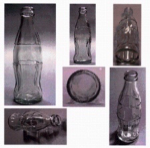Trademarks have been incorporated in our lives so seamlessly. It influences our lives from the way we identify a product or a service. From our friends vouching for a particular product to each of us being loyal to a specific brand is all dictated by how a product or service is identified. Companies and business spend millions in coming up with a catchy name and then trying to popularize it. A trademark is considered as a sign that is capable of distinguishing a product of service from one enterprise to another[i]. In India, a trademark[ii] is a mark that be represented graphically and the mark is capable of distinguishing itself from others goods or service. Further a mark[iii] can be a name, signature, a number, shape of a good, packaging of a good, a combination of colours, etc.
Different kinds of Trademark:
- Word mark and Letter mark
Word marks and letter marks are the common forms of which a trademark is registered under. Like the name suggests a word mark or letter mark consists of a particular set of words or letters in a specific arrangement that one wans to register. The benefit of registering a word or set of letters is that the word mark or letter mark can be represented in any font or format while retaining exclusive right over the word or set of letters. It provides a wider protection to the registered mark.- Examples of popular word marks are



- Examples of popular letter marks are


- Series mark
A series mark[iv] can be defined as a number of trade marks which resemble each other as to their material particulars and differ only as to matters of a non-distinctive character not substantially affecting the identity of the trade mark. The essential character of a mark is retained with minor changes to qualify as a series mark. This allows the proprietor of the mark to file a single application. Section 15 of the Trademarks Act, 1999 lays down the conditions for a series mark to be registered in India.Example of series mark is TOFKICK and TOFkick, BRITANNIA TIGER DEVICE(SERIES OF 13) (LABEL) [v]
[v] - Certification mark
It is a mark[vi] used by the proprietor to signifies the quality, origin, material etc. of his product or service. The certification mark adds as an added advantage to the products, ensuring the customers the product or service meets a particular standard. Some common examples are which is used to certify that the industrial product has met the standards set by Bureau of Indian Standards (BIS),
which is used to certify that the industrial product has met the standards set by Bureau of Indian Standards (BIS),  is used for processed food products and is issued by Ministry of Food Processing,
is used for processed food products and is issued by Ministry of Food Processing,  is used to certify that the product is sourced from Darjeeling.
is used to certify that the product is sourced from Darjeeling. - Collective mark
A Collective mark[vii] identifies a product or service of a member from an association and used only by its members. The collective mark indicates to the public specific features of the product, helps in promotion of local products in national and international markets and helps in differentiating similar products. This mark ensures that the association maintains a standard and subsequently a consumer is not cheated of their expectations of a product. It is important to note that collective marks can only be used by members of a particular company or association who own the mark, however, a certification mark can be used by anyone who complies with the standards and regulations that are set by a regulatory or a certifying body that owns the mark. Many companies also use a collective mark on its products. Some familiar examples are 
 [viii],
[viii], - Sound mark
Sounds, jingle or a tune can also play a major role in identifying a product. It is easy to differentiate a Microsoft computer from that of an Apple computer from the tune that plays when the computer is switched on. A sound mark can be a registered too. To register a sound mark[x], the musical sound must be graphically represented and the same needs to be filed in a MP3 format not exceeding 30 seconds. Some of the examples are 73553567  (MGM – Entertainment – Roaring Lion), 75807526
(MGM – Entertainment – Roaring Lion), 75807526  [xii] (Yahoo – online computer services – “YAHOO” yodel, BRITANNIA INDUSTRIES
[xii] (Yahoo – online computer services – “YAHOO” yodel, BRITANNIA INDUSTRIES  [xiii].
[xiii]. - 3D – Dimensional mark
The shape of a product or the way it is packaged massively contributed to the identity of the product if its not the product by itself. A Kitkat chocolate is easily distinguishable from a Toblerone chocolate visibly because of its shape. The shape of the chocolate has become so integrated with the chocolate that if the shape is altered then it is not Kitkat chocolate anymore. Hence, there have been provisions made to register a shape and packaging of a product. The application for registration[xiv] of a shape or packaging of a product has to be applied with at least five different views of the trademark accompanied by a description of the mark.Some popular examples are  Little Hearts 3 –D,
Little Hearts 3 –D,  shape of Coca – Bottle.
shape of Coca – Bottle. - Smell Mark
One of the strongest sense that is associated with a fond product is with its smell. For registering a smell as a mark, the smell should be visually represented and the scent must be distinct from the product[xvi]. Smell mark in India is still in the early stages and is yet to develop. A severe obstacle[xvii] that is viewed in the registration of a smell as a trademark in India it is necessary to be described on paper in a durable form. Some examples of this are Grendene’s Bubble Gum Scent for Sandals[xviii], Play-Doh[xix] which is described as a scent of a sweet, slightly musky, vanilla fragrance, with slight overtones of cherry, combined with the smell of a salted, wheat-based dough.
It has been a gradual evolution in Trademark law that began with the protection of conventional trademarks as the word, logo, etc. to include the protection of unconventional marks such as the sound or smell. There has been a constant evolution of trademark law to become inclusive of the possibilities that a product or service could be a trademark. As businesses develop new ways and strategies to make make a product one of its kind in a highly competitive market, it is necessary for the law to constantly update itself in order to protect the interests and rights of the true proprietor.
– Theekshna Amin, Associate
– Altacit Global
- https://www.wipo.int/trademarks/en/
- Section 2(1)(zb), The Trademarks Act, 1999.
- Section 2(1)(m), The Trademarks Act, 1999.
- Section 41(2) of the Trade Marks Act, 1994 http://www.legislation.gov.uk/ukpga/1994/26/section/41.
- Application No. 1734875, https://ipindiaservices.gov.in/eRegister/eRegister.aspx.
- Section 2(1(e), The Trademarks Act, 1999.
- Section 2(1)(g). The Trademarks Act, 1999.
- https://euipo.europa.eu/eSearch/#details/trademarks/018120107
- https://medium.com/@venturecare110716/types-of-trademark-in-india-company-trademark-registration-5859c8346d13
- Rule 26 (5), The Trade Mark Rules, 2017.
- https://www.uspto.gov/sites/default/files/73553567.mp3
- https://www.uspto.gov/sites/default/files/75807526.mp3
- Application No. 1913366, https://ipindiaservices.gov.in/eRegister/eRegister.aspx.
- Rule 26, Trademark Rules, 2017.
- Application No. 4274917, https://ipindiaservices.gov.in/eRegister/eRegister.aspx.
- Smell, Sound and Taste – Getting a Sense of Non-Traditional Marks, February 2009, https://www.wipo.int/wipo_magazine/en/2009/01/article_0003.html#:~:text=To%20obtain%20registration%20of%20a,kept%20on%20a%20trademark%20register.
- Smell Marks: The New Rage in Trademarks, Angela Dsouza, https://www.intepat.com/blog/trademark/smell-trademarks-india/.
- http://tsdr.uspto.gov/#caseNumber=86265443&caseType=SERIAL_NO&searchType=statusSearch
- Registration No. 5,467,089, https://www.uspto.gov/trademark.



 [v]
[v] which is used to certify that the industrial product has met the standards set by Bureau of Indian Standards (BIS),
which is used to certify that the industrial product has met the standards set by Bureau of Indian Standards (BIS),  is used for processed food products and is issued by Ministry of Food Processing,
is used for processed food products and is issued by Ministry of Food Processing,  is used to certify that the product is sourced from Darjeeling.
is used to certify that the product is sourced from Darjeeling.
 [viii],
[viii],  [xiii].
[xiii]. Little Hearts 3 –D,
Little Hearts 3 –D,  shape of Coca – Bottle.
shape of Coca – Bottle.

